A Year after the Devastating Fire at Notre-Dame De Paris
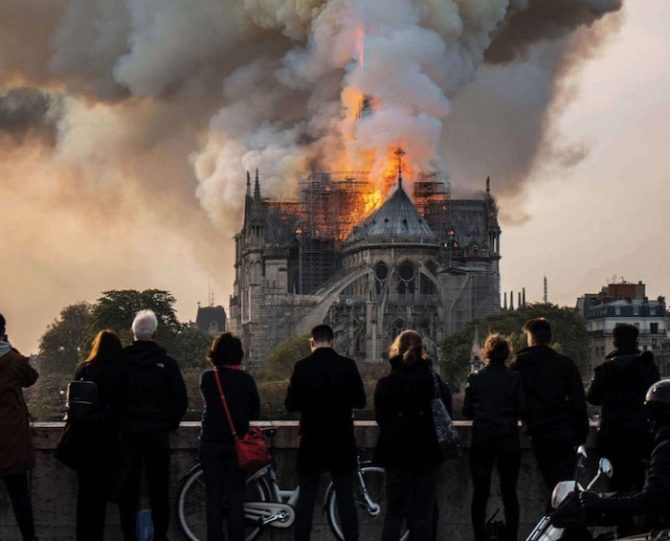
A year after the devastating fire at Notre-Dame, Caroline Harrap looks at what comes next for the world-famous cathedral – and discovers why its future could still be at risk
Standing across the Seine from Notre-Dame on the edge of the Left Bank, it’s hard to believe that this time last year a fire almost consumed this cornerstone of Paris. Illuminated by the spring sunshine, the stone façade looks immaculate, with no hint of damage, and the twin bell towers appear reassuringly sturdy. At first glance, things seem almost normal. Look a little harder, though, and the signs are there. Just to the rear of the cathedral, a tall crane towers over the site – which is itself surrounded by a vast metal perimeter fence. Inside, the throngs of wide-eyed tourists have been replaced by workers in hard hats. Most poignantly of all, there is that aching shock of empty space where the iconic spire once stood.
For so long such an integral part of the Paris skyline, the 19th-century flèche was lost to the flames on that fateful night, along with much of the medieval roof. It was one of those defining moments in history where everyone remembers where they were and what they were doing – and the sense of loss, certainly locally, is just as profound a year later.
“A neighbour phoned to tell me the news,” says British-born author, Annabel Simms, who lives just across the river from the cathedral on the Île Saint-Louis. “I didn’t believe her, but went to the window to check. There, I saw a poisonous, yellow-grey pillar of smoke belching upwards into the blue sky – with the spire, the only part of the cathedral that was visible from my window, briefly outlined in flames. Then the spire was hidden by the smoke and I never saw it again. I had been seeing it from my window for 27 years and I felt as though I’d lost a friend.”
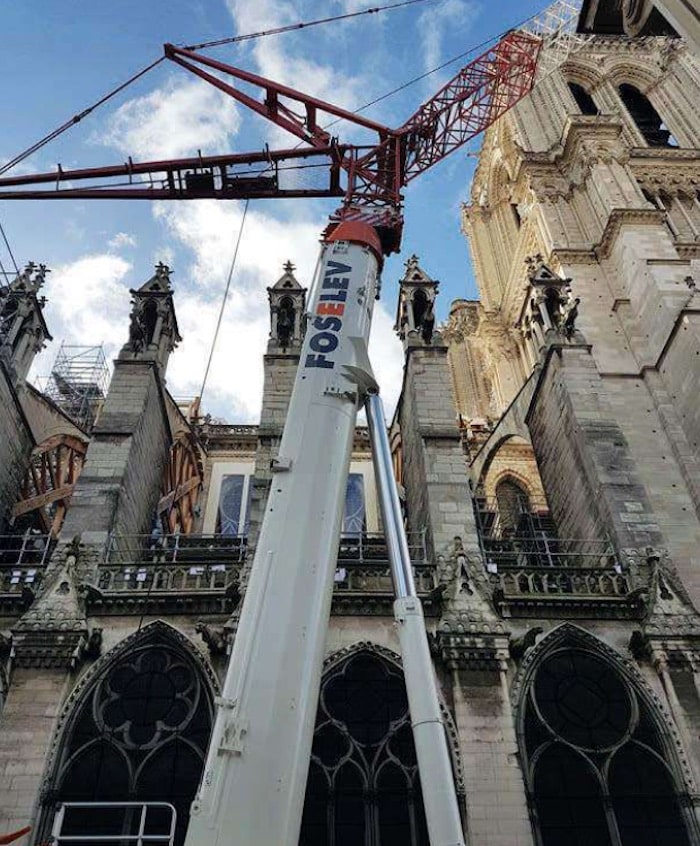
Work is underway to rescue Notre- Dame, which remains at risk. IMAGES © SHUTTERSTOCK, CAROLINE HARRAP
While the shockwaves were felt especially strongly in Paris, the tragedy prompted a global outpouring of grief – with nearly €1bn pledged in the ensuing months. There was also, eventually, a sense of relief – that things weren’t quite as bad as first feared. Not only had the cathedral’s main structure, façade and bell towers all survived, the renowned rose windows were saved – as was the famous organ and many precious artefacts. Even the copper cockerel from the top of the spire was retrieved from the rubble.
Thoughts began to turn, more optimistically, to what form the renovation might take – with the purists wanting to honour the integrity of the original structure and others pushing for a new, more modern element to reflect this latest chapter. Then there was the question of whether President Macron’s ambitious target of five years could be met. What no one was really prepared for, however, was the news that the cathedral could still be in danger.
Only recently, it has emerged that we’re not out the woods yet, with the vaults at risk of collapse even now. Whether they survive, we are told, rests on the tangled web of scaffolding that hangs ominously above. Erected in the lead-up to the fire as part of ongoing works, this mangled mesh of metalwork now has to be painstakingly removed – piece by piece – before we will know for certain.
“Even if we are rather confident and even if all the indicators seem positive, it is still too early to affirm that the cathedral is saved,” it was announced by General Jean-Louis Georgelin, the man overseeing the restoration, shortly before France Today went to press. “We will be able to say this when we have completed the dismantling of the scaffolding – and when we can inspect the vaults in detail.
“So, the two main stages are the removal of the scaffolding, which will allow a final diagnosis, and the launch of the restoration studies. Then we can schedule the work to be done.”
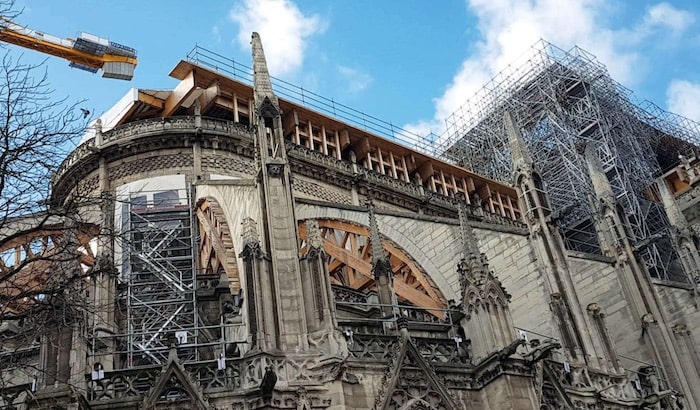
The view from the rear of the cathedral today as work to restore it is carried out. IMAGES © SHUTTERSTOCK, CAROLINE HARRAP
For now, the aim is to complete the removal of the scaffolding by early summer – assuming all goes to plan – and clear up any remaining lead residue. Only then will the final decision be made as to how to rebuild Notre-Dame – with renovation work expected to begin in earnest from 2021. [Editor’s note: Due to the coronavirus pandemic, the work has been put on hold.]
In the meantime, a consultation is under way over what form that renovation should take. At the heart of the debate is the distinctive lead spire, which was added by Eugène Viollet-le-Duc in the mid- 1800s, and whether its replacement should be an exact replica or a modern alternative. Another point of much conjecture has been the famous ‘forested’ roof. Made from more than 1,000 medieval oak trees, it has been questioned whether it would even be possible to recreate it in the same way today.
One person well placed to comment is Florian Renucci, the master- mason at Guédelon, in Burgundy, where they are constructing a medieval castle from scratch using original techniques. Based on their experience, he says there is certainly no logistical reason why the roof couldn’t be restored in a way that respects the original structure.
“It is perfectly possible to rebuild Notre-Dame exactly as it was before,” says Florian. “Firstly, we have more than six million hectares of oak woodland in France. Notre-Dame only needs around 1,000 trees, so if each town or village gave one, it would be done. Secondly, there’s so much fake news on the subject – for example, that we have to wait 1,000 years for the wood to be old and dry enough: wrong. All the wood used in medieval times was unseasoned. Lastly, there’s a misconception that we don’t have the people to do it, but that’s simply not true either.
“Here at Guédelon, we have the skilled craftspeople, the techniques and the economic model. It’s true that the renovation in its entirety would take longer than five years, but why not make the reconstruction part of the story – helping to create a new generation of carpenters in the process? It would still be possible to shore up the structure within five years – meaning that the cathedral could also welcome visitors again within the desired time frame.”
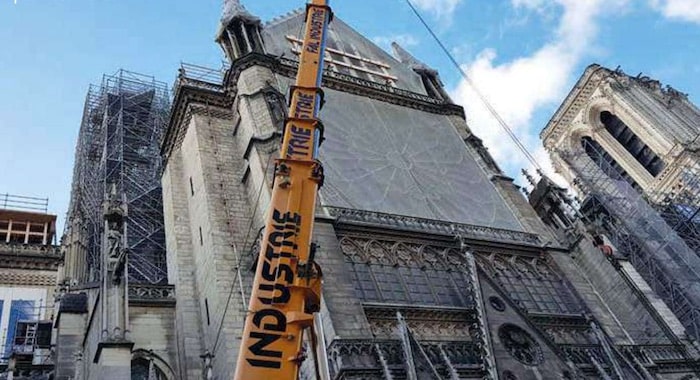
Looking up at the ongoing structural works. IMAGES © SHUTTERSTOCK, CAROLINE HARRAP
Which brings us nicely on to the other major talking point – the overall timeline for the project. When Macron famously announced a goal of five years for the restoration to be completed, possibly with an eye on the 2024 Olympics, this was met with more than a few raised eyebrows. But there does seem to be a general consensus now that, vaults permitting, it might just be feasible for the cathedral to at least be accessible again within five years. Then, alongside welcoming visitors, the rest of the renovation could continue for as long as needed. In fact, it could even be a part of the experience.
“While the aim seems to be to complete the main structural work by 2024, other things – such as the restoration of the organ and the stained-glass – will be going on for years,” says Olivier de Châlus, a former supervisor of the official tour guides, who is doing a PhD on the cathedral’s construction. “So, the idea would be to welcome visitors again, but that the ongoing renovation would be incorporated into their visit.”
Hopes for the Future
“Equally importantly, we need to think of the human patrimony of the cathedral; for example, many of the tour guides were in their 60s, so, if we wait much longer, there is a danger that some of them won’t come back. Then all that specialist knowledge will be lost forever.”
Meanwhile, though the cathedral itself may be out of bounds, there are several ways that people can stay connected with Notre-Dame. For example, services are still being held at other nearby churches – and the celebrated musicians of the cathedral are continuing to stage concerts at other venues.
Furthermore, an exhibition of photos, showing the extent of the disaster and the scale of the restoration work, has recently been installed on the perimeter fence. With explanatory text in both French and English, it’s become an important new focal point for visitors. In addition, the aforementioned copper cockerel is now on display at the Cité de l’Architecture et du Patrimoine – along with statues from the spire – and there’s even talk of a major exhibition showcasing Notre-Dame’s other treasures. For now, though, many people take pleasure simply in seeing the cathedral still standing – with the building once more being lit up at night. It should also be noted that the rest of this vibrant area is still very much open for business.
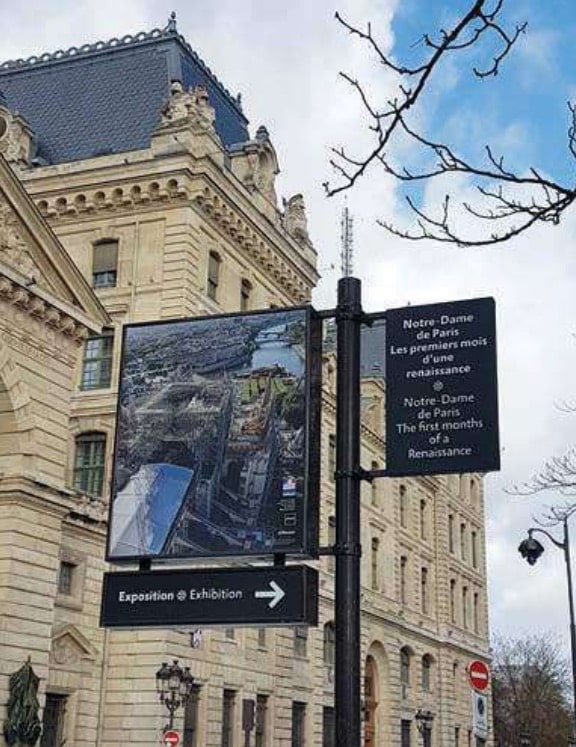
A new photo exhibition about the renovation has recently opened on the metal perimeter fence.
IMAGES © SHUTTERSTOCK, CAROLINE HARRAP
“In the absence of visiting Notre-Dame, visitors will find a neighbourhood full of charming boutiques and restaurants to discover,” says Jane Bertch, founder of the international cookery school, La Cuisine Paris, which is just across the Seine from the cathedral. “At the end of the day, we are all part of a living history – and those who visit now have a rare chance to see and be a part of this exciting new chapter for Notre-Dame.”
Talking Tech
If there is one silver lining that can be found in the Notre-Dame fire, it is the opportunities it offers to learn more about the history of the cathedral, the techniques used to build it and even the climate during medieval times.
For example, the oak trees used to construct the roof ’s wooden structure grew during a hot spell in Europe known as the Medieval Warm Period. The frame’s scorched beams, now being meticulously documented and analysed, could provide further details of this – perhaps even helping us to better understand contemporary climate change.
Also, even now, little is known about the construction of the cathedral – such as the techniques used by the builders to lift such heavy blocks of stone so far off the ground. It is hoped that a deeper study of the materials used could provide vital clues.
Needless to say, state-of-the-art technology is being utilised throughout every aspect of the process – from a microscopic study of the surviving remnants of the blaze in order to give an exact diagnosis of Notre-Dame’s condition, to the remote-controlled robots removing debris from the nave.
In addition, experts have been able to call on exact digital plans of the cathedral created prior to there by French architectural scanning rm, AGP, who had mapped every last millimetre of the structure.
If you would like to donate to the Notre-Dame appeal, visit don.fondationnotredame.fr/cathedrale
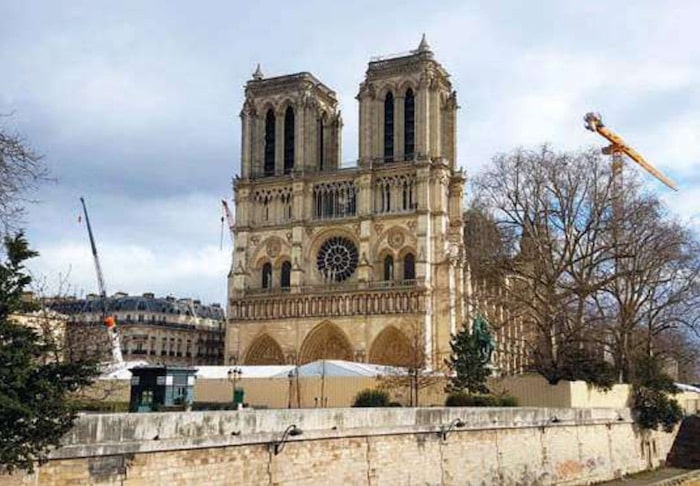
Notre-Dame as seen from across the river on the Left Bank – at a glance, it is easy not to notice the terrible toll of the fire. IMAGES © SHUTTERSTOCK, CAROLINE HARRAP
Notre-Dame: Need to Know
Regarded as one of the greatest Gothic cathedrals in the world, Notre-Dame is the most visited monument in Europe. Construction began under the reign of Louis VII, in 1163, and the building was finally completed almost 200 years later.
Located right in the heart of Paris, on the Île de la Cité, this masterpiece of medieval architecture has been the scene of many important events over the centuries. As well as the crowning of King HenryVI of England in 1431, Napoleon’s coronation took place there in 1804. Later, it was immortalised in Victor Hugo’s 1831 novel, The Hunchback of Notre-Dame.
During its lifetime, the cathedral has survived everything from the French Revolution to two World Wars and has been renovated several times – most notably by Eugène Viollet-le-Duc in the mid-1800s. It was undergoing routine works when the fire broke out on the evening of April 15, 2019. The cause of the blaze remains unknown.
From France Today magazine
Share to: Facebook Twitter LinkedIn Email
More in cathedral
Leave a reply
Your email address will not be published. Required fields are marked *




REPLY